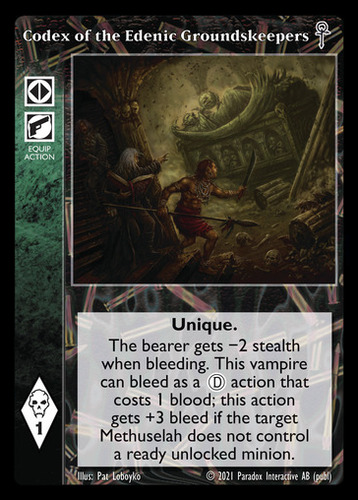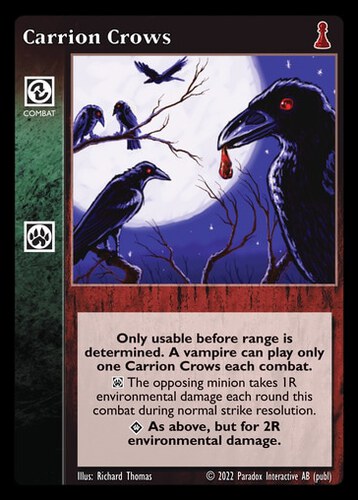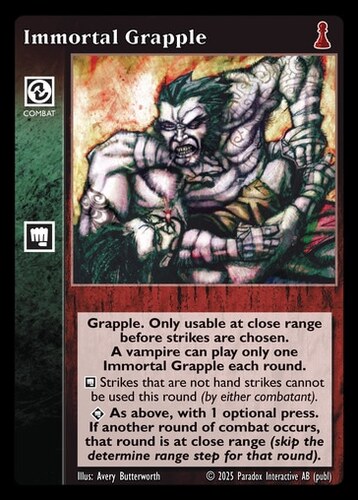Combat Primer
by Krzystof Karski
As soon as I started writing this article I realized that the topic is so broad and complex that it would take forever to explore all its facets. Thus, in this primer, I will focus on the basics and cover only the most common combat doctrines you can encounter, so no bloodline or niche discipline.
Why and how to play combat?
The common misconception about combat among newer players is that combat is a goal in itself, focusing on eliminating minions and little else. This is a wrong approach, even though it can be fun to tear off limbs and see everything burn, at least for the one doing the tearing and burning, it does not bring you any closer to victory in and of itself.
When thinking about combat in VTES you must first and foremost think of it as a tool of control. No other type of deck can reach all across the table and control the distribution of resources. If someone (primarily your prey and predator) gets too strong at the table you can always visit them and take some of their blood for yourself, or reduce their headcount to slow them down. Most commonly, combat decks will make their predator the target of their first rush, to reduce pressure on their back and be able to focus all of their attention on their prey.
It is of utmost importance to remember that combat is just a tool to help you win, not a win condition. When building a combat deck, you must think of how your deck will oust the prey first and foremost. Quite often fledgling combat aspirants forget about this and focus all of their efforts on sending vampires to torpor only to discover too late that then they have no way of reducing their pool fast enough: they get left behind in the race for victory points.
 Ties in directly into your strategy by allowing you to take pool at the same time as you fight.
Ties in directly into your strategy by allowing you to take pool at the same time as you fight.
 Similar purpose but has the downside of you not being in full control of who will lose pool at all times.
Similar purpose but has the downside of you not being in full control of who will lose pool at all times.
 Capitalizes on minions already being in torpor.
Capitalizes on minions already being in torpor.
 Speeds up your bleeding when there are no defenders left.
Speeds up your bleeding when there are no defenders left.
Any dual-purpose cards that let you take pool or enter combat like Deep Song or Line Brawl are also very good additions since you will most likely need all the deck space you can get for efficient combat. Once you have solved the question of ousting power, you will also have to think about the challenges you might face. For combat decks, those typically boil down to:
- Maneuvers: if you fight at close range, you must be able to beat at least one maneuver.
- Dodge & Combat ends: nothing is more frustrating than having all your damage whiff so having an answer to that is top priority.
- Damage prevention: unfortunately outside of a few specialist choices there is very little you can do about it. Some presses can help to continue combat.
- Enemy combat: again, little you can do about it, a fight between two combat decks often boils down to a coin toss and there are just too many permutations to be ready for everything.
How to play against combat?
Being on the receiving end of a combat deck is rarely fun, some even find it the worst experience in VTES that saps their will to play. Do not despair though as all is not lost even if you are being hurt badly, there are ways of dealing with combat that most decks can do. In general, you will want to make yourself an undesirable prey for the combat deck to discourage rushes. Combat decks have limited resources and spending them can be a tough decision. Here are some simple ways to stimmy the predations of a rush-happy deck:
Delay
In the beginning, if you know that your prey or predator is a combat deck, you can delay your start a bit to bring out 2 vampires at the same time. There is little direct threat to your pool early on from the combat deck, so delaying your start should not be a problem, whereas having more than one target now means they need to expend more actions to take you offline completely.
Talk
Talk to people. This is often the simplest but most forgotten way of dealing with combat. If you are being slaughtered just ask around the table for others to help rescue your vampires from torpor or — in case you are the predator of a combat deck and have been rushed to oblivion — slow down their advances toward you so you can rebuild and pose a threat to combat again. Most people should be happy to do so because this brings you back as the primary target and takes this burden off of them. At some point, a combat deck will run out of resources or decide to focus them elsewhere and let you play your game. Patience is a virtue.
Rescue
Rescue, rescue, rescue. Rescue your vampires, rescue other people vampires. It is a war of attrition after all and if you just do nothing you have already lost.
Remove blood
Remove blood from your vampires. If you are facing combat and you know you cannot get away then make yourself a less desirable target. Villein down your vampires as much as you can, this helps build your pool and also reduces the effectiveness of combat. If you do not have blood they cannot take it from you and they may overspend resources without need.
Block
Have some chump blockers. Small minions are typically undesirable targets for combat decks. Having to waste an action and potentially some combat cards to send an Embrace with no blood to torpor or fight Jake Washington is not something a combat deck wants to do. Smaller vampires can protect your more important ones.
Common combat modules
Allies


Those decks typically bring allies to fight for them. The most common examples here would be Nephandus, who can both bleed and fight as well as scary War Ghoul. Those decks do not pack a very large combat package, but they are extremely efficient with it. Nephandus playing Trap does 5 damage while taking none itself (assuming fighting a vampire that does nothing in combat), War Ghoul with Trap can do a whopping 16 damage in one combat. They will sometimes also add low quantities of other combat cards that might help them dish out damage a bit faster or provide extra effects. Molotov Cocktail, Target Vitals, and Pulled Fangs are such cards. They will also use The Unmasking to help protect their pool.
Guns


Guns are used quite often because of the high efficiency they provide. Having a built-in maneuver and strike is extremely useful throughout the game. Everyone can use them and with the help of Concealed Weapon, you can equip them in combat and not risk getting your equip action blocked. The most common gun you will see is the .44 Magnum, but there are a few decks that run the cheaper Saturday Night Special in combination with Dragon’s Breath Rounds, sacrificing the long-term efficiency of guns for short-term bursts of aggravated damage at long range.
Sticks


Some decks do not use disciplines but like to fight anyway. If they are not using guns, they might be using Weighted Walking Stick for some extra damage and an assortment of aim cards to boost it. Target Vitals, Target Head, etc.
Animalism


Animalism has long been one of the premier combat disciplines due to its efficiency. Deep Song provides both extra bleeding and a rush, Aid From Bats provides damage coupled with maneuver and a press while Carrion Crows provides extra environmental damage. This is a very neat and easy-to-use combat package that also has access to some bonus effects like weapon destruction (Canine Horde, Voracious Vermin) or denying your opponent’s presses and maneuvers with Terror Frenzy or Drawing Out the Beast. Its only downside is the lack of an answer to Combat Ends effects, making it unreliable when fighting against decks that have a lot of them.
Celerity


Most commonly paired with guns but can also be used as a supplementary discipline for other types of combat. Best known for providing plenty of maneuvers, dodges, and additional strikes, letting you deal a lot of damage in a single round of combat. Also provides one of the best ways of dealing with Combat Ends in the form of Psyche!, which is also wonderful with .44 Magnum as it resets the fight and thus allows you to use the maneuver from the gun again.
Fortitude


Not much to say here. Having access to damage prevention is always good in combat. Additionally, it provides decks with Freak Drive for multi-acting so you can either rush multiple times in a single turn or do a combination of rushing and bleeding.
Potence


This is the combat discipline, seeing how there are very few cards for it outside of combat cards. Being able to do high damage thanks to cards like Torn Signpost and Roundhouse, dealing with dodges and combat ends thanks to Immortal Grapple as well as sending people straight to torpor with Disarm or burning them outright with Decapitate. It does not come without its downsides though. Most of it only works at close range with very few options for maneuvering, and it also puts your vampire at risk of getting hit back.
Blood Sorcery


Pretty light combat but worth mentioning. Famously used for life-stealing effects which bypass damage prevention and help you come out on top with resources thanks to cards like Theft of Vitae, as well as access to maneuvers thanks to Apportation, limited damage prevention with Rego Motum, and aggravated damage like Walk of Flame. Blood Sorcery is not known for being a scary combat, but it definitely can pose trouble for some decks and help ensure you are pulling ahead.

